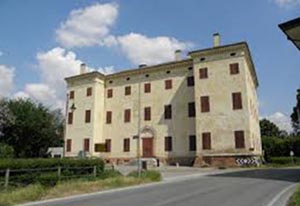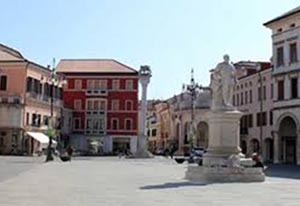TRECENTA
Trecenta dates back to the time of the Romans, who wrested it from the Etruscans in 163 B.C.E., establishing the military camp 130 (Centum Triginta) Roman miles from Rimini under the name of Annejanum. Due to its strategic position, Trecenta was sacked by the main barbarian tribes between 263 and 774, when it came under the Papacy.
In 1017, Richelda, wife of Boniface IV of Tuscany, donated the town to the Abbey of Nonantola. It was then a fiefdom of the Bishop of Ferrara, who passed it to the Este family.
From 1208 to 1799 it was ruled by the Este family and then by the Church; under their administration the marshes surrounding the town were reclaimed. Invasions went on from 1701 until 1796 and the arrival of Napoleon. After the Congress of Vienna in 1815, a sub-society of the Carboneria was formed in the town, meeting at Villa Trebbi.
Trecenta became part of the Kingdom of Italy in 1866. In 1928 the municipality included the suppressed municipality of Crocetta in its territory.
After the flood of 1882, many inhabitants emigrated to South America. This was repeated in 1951 when, after the flooding of the Po on 14th November, the town saw its inhabitants shrink to under 3,000.
Worth Visiting
The Church of San Giorgio, in an area once called Pieve. It was built in the 17th century in the Ferrara Baroque style based on a design by Santini
The Oratory of the Beata Vergine della Consolazione known as Santa Chiara
The Church of San Maurelio (in the Sariano district) with frescoes from the 1300s attributed to the school of Giotto, and others dating from the 1400s and 1500s. In the apse is an altarpiece attributed to Guercino with the image of St Maurelius
Palazzo Pepoli, known as “el Palazzòn”. This has existed since the Middle Ages as a four-tower defensive building. It was owned by the Contrari family and then inherited by the Pepoli family at the end of the 16th century
Villa Trebbi – Villa della Carboneria. Currently the town hall, it was built in the second half of the 18th century by the Trebbi family. It is remembered for the history of Polesine’s Carboneria
Torre Civica, erected in 1888, the tower, along with the former church bell of Bagnolo, was used to summon the municipal councillors. Today, only a small symbolic bell remains, and the building is used as the local police headquarters, municipal library and conference and training rooms
Casa Pepoli, commonly known as “Il Castello”, in the district of Sariano
Corte Gaspera, on the northern bank of the pool of the same name
Don’t Miss
The Trecenta pools are an area of wetlands that are evidence of ancient floods, located in depressions in the terrain. These small lakes have created an environment that is particularly rich in lake flora and fauna



